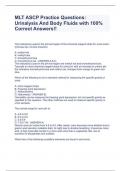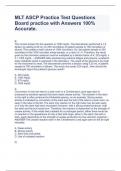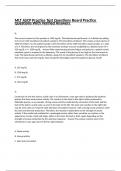Mlt ascp practice stuvia - Study guides, Class notes & Summaries
Looking for the best study guides, study notes and summaries about Mlt ascp practice stuvia? On this page you'll find 15 study documents about Mlt ascp practice stuvia.
Page 2 out of 15 results
Sort by

-
MLT ASCP Practice Questions: Urinalysis And Body Fluids with 100% Correct Answers!!
- Exam (elaborations) • 20 pages • 2023
-
- $11.99
- + learn more
The indicator(s) used in the pH test region of the chemical reagent strips for urine is/are: (Choose ALL correct answers) A. methyl red B. methyl blue C. bromothymol blue D. bromothymol red - ANSWER-A & C; The indicator(s) used in the pH test region are methyl red and bromothymol blue. Typically on most chemical reagent strips for urine pH, with an increase in urinary pH, the indicators bromothymol blue and methyl red, changes from orange to green and blue. Which of the following is no...

-
MLT ASCP Practice Test Questions Board practice with Answers 100% Accurate!!
- Exam (elaborations) • 31 pages • 2023
-
- $12.49
- + learn more
B; The correct answer for this question is 1300 mg/dL. The laboratorian performed a 1:4 dilution by adding 0.25 mL (or 250 microliters) of patient sample to 750 microliters of diluent. This creates a total volume of 1000 microliters. So, the patient sample is 250 microliters of the 1000 microliter mixed sample, or a ratio of 1:4. Therefore, the result given by the chemistry analyzer must be multiplied by a dilution factor of 4. 325 mg/dL x 4 = 1300 mg/dL. - ANSWER-After experiencing extreme fat...

-
MLT ASCP Practice Questions & Answers 100% Correct
- Exam (elaborations) • 13 pages • 2023
-
- $11.99
- + learn more
Standard precautions apply to all of the following except: a. Blood b. Cerebrospinal fluid c. Semen d. Concentrated acids - ANSWER-d. Concentrated acids The most important practice in preventing the spread of disease is: a. Wearing masks during patient contact b. Proper hand washing c. Wearing disposable laboratory coats d. Identifying specimens from known or suspected HIV- and HBV-infected patients with a red label - ANSWER-b. Proper hand washing The appropriate dilution of bleach...

-
MLT ASCP Practice Test Questions Board practice with Answers 100% Accurate.
- Exam (elaborations) • 30 pages • 2023
-
- $11.49
- + learn more
A. 325 mg/dL B. 1300 mg/dL C. 975 mg/dL D. 1625 mg/dL A; Conversion of only the slant to a pink color in a Christensen's urea agar slant is produced by bacterial species that have weak urease activity. The reaction in the slant to the right is often produced by Klebsiella species, as an example. Strong urease activity is indicated by conversion of the slant and the butt of the tube to a pink color, as seen in the tube to the left. The slant only reaction in the right tube may be seen ear...

-
MLT ASCP Practice Test Questions Board Practice Questions With Verified Answers
- Exam (elaborations) • 41 pages • 2023
-
- $12.99
- + learn more
B; The correct answer for this question is 1300 mg/dL. The laboratorian performed a 1:4 dilution by adding 0.25 mL (or 250 microliters) of patient sample to 750 microliters of diluent. This creates a total volume of 1000 microliters. So, the patient sample is 250 microliters of the 1000 microliter mixed sample, or a ratio of 1:4. Therefore, the result given by the chemistry analyzer must be multiplied by a dilution factor of 4. 325 mg/dL x 4 = 1300 mg/dL. - Answer After experiencing extreme fat...

That summary you just bought made someone very happy. Also get paid weekly? Sell your study resources on Stuvia! Discover all about earning on Stuvia


